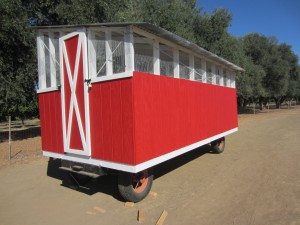
What’s that cool structure in that UC Davis research field? It’s an egg mobile! Egg mobiles are exactly what they sound like — a mobile chicken coop that can be towed to a different location, such as a different area of a pasture. There are nestboxes and roosts inside for the egg-laying chickens; they also have an opening for the chickens to freely move between the outdoors and inside the coop.
In collaboration with the labs Debbie Niemeier and Maurice Pitesky, we are studying the intricate details of mobile chicken coops. We have visited many farms around California, from San Luis Obispo to Grass Valley, that have mobile coops. Our criteria are that the farms have less than 3000 chickens and they sell their eggs commercially. The Niemeier and Pitesky labs are interested in the presence of Salmonella in these coops — both in the chickens and in their environment. As a seasoned member of the Eisen lab, I am of course tagging along to collect built environment samples of each of these farms.
The research is quite exploratory, but we have collected some great data. We have completed 3-page surveys from all of the farmers answering questions ranging from the health of their flock to egg food safety practices. We have collected measurements of all of the mobiles, what materials they are made out of, and dimensions of roosts and nests. We drew a small blood sample from about 3 dozens chickens per farm (depending on the flock size) to test for the presence of salmonella antibodies. This brings some humor into the field; we realized on one farm where every chicken tested positive that the whole flock had been vaccinated. We collected a cloaca swab for chickens that tested positive in the antibody stain because the test is prone to false positives. Additionally, we collected drag swab samples (gauze soaked in condensed milk) in and around the coops to specifically test for salmonella in the environment. And lastly, we have collected dry swab samples of the roosts, nestboxes, floors, food, and water from each mobile for 16s sequencing to determine what microbial communities live in and around the coops.
The Niemeir lab has taken this project one step further, and is actually building their own mobile coop. Through this project, we can have rough answers as to what variables of coop construction reduce the occupational hazards for workers in and around the coops, as well what factors improve the health of the chickens that live in these pasture homes. With the new UCD chicken mobile almost complete, we now have the perfect opportunity for a longitudinal study of how the microbial community of the coop changes from the very the day the pullets arrive.
Is there anything you’re dying to find out about mobile coops that our sampling can answer?
One thought on “UC Davis Egg Mobile Project”